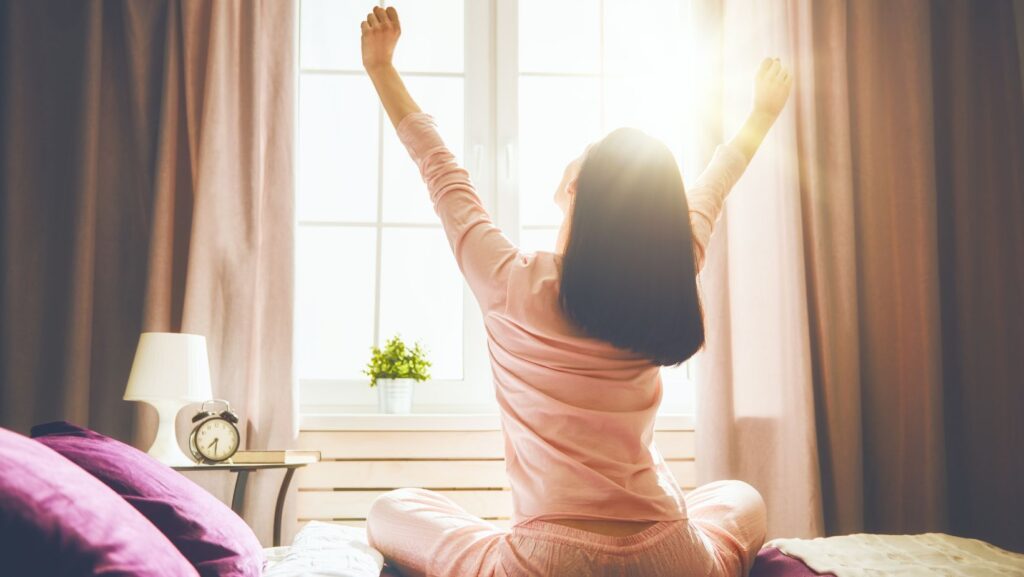That groggy, sluggish morning feeling sabotages your entire day before it begins. Your brain feels foggy, your body moves like it’s underwater, and your motivation hibernates somewhere between the sheets. Skip the generic “wake up at 5 AM” advice – let’s dive into morning rituals that work with your body’s natural rhythms. While most morning advice focuses on willpower, these methods tap into your body’s biological systems to create sustainable energy.
Light Exposure: Your Internal Clock’s Perfect Friend
Your circadian rhythm needs a clear “wake-up” signal. Natural sunlight triggers a cascade of alertness hormones. Step outside early in your morning routine – even on cloudy days, outdoor lighting is significantly brighter than indoor lighting. This helps reset your internal clock and signals your body to reduce melatonin production. Morning light exposure also coincides with your body’s natural cortisol rhythm, which peaks in the early morning hours to help increase alertness.
For night owls, gradually shift your light exposure earlier in small increments. Your body adapts better to gradual changes than sudden ones.
Kitchen Hack: Position your coffee maker near a window. You’ll naturally gravitate toward light while waiting for your brew. Install a mirror opposite the window to increase ambient light while you prepare breakfast.
Modern Energy Enhancement Options
The wellness market offers various morning energy enhancement options beyond traditional caffeine. For those in areas where cannabis products are legal, various cannabis edibles provide an alternative to conventional supplements. These sugar free cannabis edibles can be incorporated into a morning routine. The absence of sugar helps avoid rapid blood glucose fluctuations that can affect energy levels.
CBD products represent another modern approach to morning energy management. Unlike THC, CBD doesn’t produce psychoactive effects. Research suggests CBD may help with morning alertness by supporting the body’s natural endocannabinoid system. CBD comes in various forms – oils, capsules, and infused drinks. Some users report improved focus and reduced morning anxiety with CBD use.
Adaptogens offer another evidence-based option for morning energy enhancement. These natural substances help the body manage stress and maintain energy balance. Common morning adaptogens include:
- Rhodiola rosea: Studies indicate it may help reduce mental fatigue
- Cordyceps: Research shows potential benefits for physical energy
- Ashwagandha: Known to help balance stress hormones
Nootropics represent the latest trend in morning energy optimization. These cognitive enhancers range from natural compounds like L-theanine (found in green tea) to synthetic options. L-theanine paired with caffeine has shown particular promise for sustained morning alertness without jitters.

Some people combine multiple approaches – for example, using CBD with adaptogens or pairing sugar-free cannabis products with nootropics. The key lies in finding combinations that work for your body chemistry and lifestyle.
Important: Always consult healthcare providers before incorporating any supplements into your routine. Start with minimal amounts and carefully monitor your response. Follow local regulations regarding cannabis products. Be aware that the supplement industry isn’t strictly regulated – research products and brands carefully.
Timing Tip: Record how different supplements affect your energy levels throughout the day. Some people find morning supplements work better on an empty stomach, while others need food first.
Temperature Contrast: Wake Up Your Nervous System
Alternating between hot and cold water in your shower activates your sympathetic nervous system. Research shows that controlled exposure to cold water can increase alertness and energy levels. This practice, known as hormesis, creates mild stress that can help build resilience. Cold exposure has been linked to increased norepinephrine levels and improved circulation.
For sensitive individuals, start with mild temperature contrasts and gradually increase the difference as your body adapts.
Pro Tip: Keep a warm robe or towel nearby. You’re more likely to maintain this practice when you’re comfortable afterward.
Movement Snacking: Break Up Morning Stiffness
Instead of a lengthy morning workout, scatter brief movement breaks throughout your routine. Simple exercises like squats while brushing teeth, counter push-ups while waiting for coffee, or doorway stretches between tasks can be effective. These micro-sessions help maintain joint mobility and promote blood flow. This approach can provide benefits while avoiding the fatigue that sometimes follows intense morning workouts.
Space Hack: Install resistance bands on your most-used doorways. They’re always ready for a quick movement break. Keep basic exercise equipment visible and easily accessible.
Protein Timing: Fuel Your Brain
Research supports the benefits of morning protein intake for cognitive function and energy levels. Both animal and plant-based proteins can be effective. Including healthy fats and electrolytes with your protein can support sustained energy levels.

Prep Tip: Prepare your protein source the night before to remove morning decision-making. Keep backup options in convenient locations for busy mornings.
Oxygen Loading: Prime Your Cells
Most people tend to breathe shallowly in the morning. Deep breathing exercises, particularly those engaging the diaphragm, can help increase oxygen intake and energy levels. Focus on full exhalations followed by natural inhalations. This type of breathing has been shown to affect the vagus nerve, which plays a role in wakefulness and alertness.
Breathing Hack: Place your alarm across the room. The walk to turn it off naturally encourages movement and deeper breathing.
Sound Strategy: Auditory Awakening
Harsh alarm sounds can trigger a stress response that persists throughout the morning. Instead, use sounds that gradually increase in volume. Natural sounds like birdsong or gentle music can provide a less jarring transition from sleep. Various apps offer customizable sound options that align with healthy wake cycles.
Tech Tip: If you use smart home devices, program gradual changes in both sound and light to create a more natural waking environment.
The effectiveness of morning rituals depends on consistency and personalization rather than rigid rules. Experiment with combining these elements to suit your schedule and preferences. Pay attention to how different combinations affect your energy levels and adjust accordingly. The goal isn’t to follow someone else’s perfect morning – it’s to discover what works best for you.
